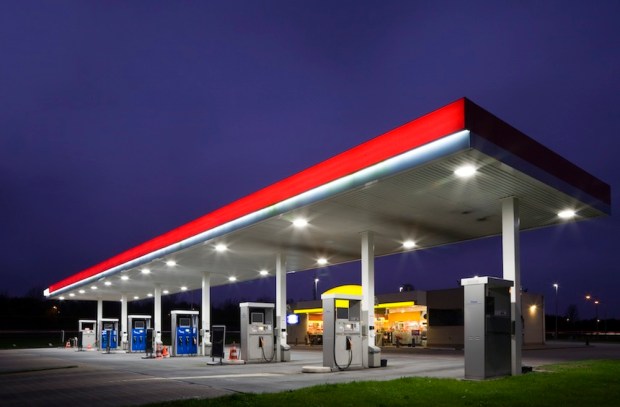Stuzo: Open Platforms Give Station Operators A Hand At The Pump

The gas station — and the convenience store — experience. Reimagined. One need no longer schlep out of the car to the pump, braving hail and sleet to find a numb-fingered grip on the nozzle to fill the tank, fumbling for a card to insert into the slot and pay. One need no longer trudge […]
The gas station — and the convenience store — experience. Reimagined.
One need no longer schlep out of the car to the pump, braving hail and sleet to find a numb-fingered grip on the nozzle to fill the tank, fumbling for a card to insert into the slot and pay.
One need no longer trudge into the store, the opposite of (to steal a line from Papa Hemingway) a clean, well-lighted place, for hot dogs that pre-date … well, let’s not think about that.
Here, then, is the promise of eCommerce at the station, where checking in at the pump and buying gas … and finding one’s way to coffee and donuts (fresh!) is a seamless consumer experience, one made simple amid taps of a mobile wallet or the thumb recognized by biometric tech.
It’s an experience Aaron McLean, COO of Stuzo, told PYMNTS in an interview that station operators want to enable, but a challenge to pull off given the complexity of integrating all of the point solutions from a variety of vendors that station operators use to support each step on the consumer’s path to purchase.
“Some of those vendors focus more on web; some shops focus more mobile,” said McLean, “and some are now targeting kiosks or even conversational interfaces like Facebook Messenger bots or Amazon Alexa bots. The challenge for the station operator is that they have different vendors … building different pieces of middleware which can be redundant.”
Along with that redundancy, McLean said, there is the creation of multiple, and different, points of inner interface which expose the retailer to greater risk of security and fraud.
Making those integrations easier to manage for the IT departments, and new features easier to onboard for the digital marketing teams, is why McLean said that Stuzo developed its Open Commerce Application Server and Command Center, a solutions-agnostic platform to bring digital experiences — of the consumer kind — to fuel and convenience retailers with a single API.
Open Commerce launches today, June 12, 2018.
At its basic product level description, McLean said the middleware, PCI DSS Level 1 compliant, integrates digital services from several vendors — spanning loyalty platform providers, POS manufacturers, mobile wallets players and, of course, the fuel and convenience store operators, to name just several, into one interface.
Output to merchants rendered in dashboards give a holistic view of the consumer. The goal is to offer up consumer insights that might otherwise be overlooked so that retailers can tailor the payments and shopping experience in real time.
Through the Open Commerce offering, McLean said vendors (through their developers) can build consistent commerce applications that consume far-flung data and give a comprehensive view of that consumer.
“Open commerce,” McLean told PYMNTS, offers a “single version of truth for the digital consumer.”
Stuzo’s customers are the retailers, he said, and the partners are the other digital services providers.
McLean said Open Commerce was created to address the needs of two different, but complementary, stakeholder groups within the gas and convenience store ecosystem.
One segment lies with IT and payments professionals who care about security and minimizing redundancy across their vendor landscape, he said. The one thing that IT teams hate more than having multiple points of failure and having multiple systems that all do the same thing across multiple vendors is tying up resources who could be deployed on other projects.
The marketing team is another constituent, McLean said, which wants to bring new products and services to market as quickly as they can. Cementing a one-to-one relationship with consumers that will be a personal one in nature is difficult but pays dividends. One of the goals of Open Commerce is to get consumers at the pump to make the leap to store purchases so the retailer can sell higher margin products, particuarly using their mobile devices where the average order value, McLean said, is 30 percent higher than a regular non-mobile user.
“As a marketer, you are looking at this data, and it is compelling,” he said. Thus, the advent of digital commerce at the gas station and at the on-site convenience store is a natural pursuit of station operators and retailers alike.
The gas and convenience station interaction envisioned by Stuzo through Open Commerce is continuous — alerts tell drivers where the nearest stations are, which locations are set up for mobile payments, with a tap at the pump. Once at the pump, and paying, a tailored commerce experience looms. The convenience store serves up offers tied to what’s being promoted in-store, from food to drinks. Paying at the pump, the consumer gets a prompt for a free coffee, perhaps a sandwich or a “buy one, get one free” offer.
“From day one, there’s a great opportunity,” said McLean, “to give the consumer a message that would bring them into the store and as consumers start doing more and more transactions.”
The retailer, in turn, builds a profile of each consumer based on past behavior, and new offers can become personalized and predicative, something that McLean called the “Holy Grail” for marketers.
“Once you go mobile, this gives the retailer an amazing opportunity that they have never had before — the ability to have a conversation with the consumer, while they are at the gas pump, at a one to one level,” McLean added.
